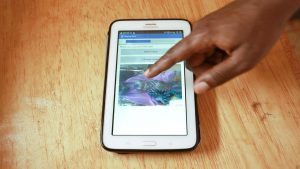
To improve Community based Management of Acute Malnutrition (CMAM) quality of care and data accuracy, health workers were given a tablet with a CMAM Application to help them assess, treat children with acute malnutrition as well as advise the mother and follow up post treatment. The software also allows decision makers to receive accurate treatment data live and respond to needs more promptly The application assists health workers in providing a portable aid to follow the treatment protocol, streamline and standardise health education messages. mHealth assists health workers give accurate diagnosis and treatment of malnutrition and follow up children over time and identify defaulters. Online data submission is faster, cost effective and secure compared to paper registers and automatic data summaries generated on the mHealth dashboard is made available for County and sub-county health management for supervision and decision making. Severe Acute Malnutrition (SAM) is a major cause of death in children under five. Its prevention and treatment are critical to child survival and development. Community based Management of Acute Malnutrition (CMAM) enables community health workers and volunteers to identify and initiate treatment for children with acute malnutrition before they become seriously ill, using ready-to-use therapeutic foods (RUTF) – a high-energy, micronutrient enhanced paste which mothers can give their children at home. However, the success of CMAM is limited if treatment protocols are not followed, record keeping and data management is poor and reliable data is not available in time for decision makers. A CMAM mobile health application was developed by World Vision and Dimagi in 2013 to guide health and adapted by Save the Children in Wajir, Kenya to help health workers treat children with acute malnutrition and provide data to decision makers to respond quickly to surges in caseloads. The mHealth app provides health workers with simple, step-by-step guidance to help them assess, treat or refer children visiting the CMAM programme. The app is built on the open source ODK (Open Data Kit) platform, which uses a touch swiping function to take health workers through the steps, remind them of the treatment protocol and counselling messages and calculate z-scores and numbers of RUTF sachets and routine medications. It also records the child’s information making child follow up easier and uploads the data to the ‘cloud’ providing live and accurate data for district level management. The mobile health app development and piloting was made possible thanks to the financial support of the Office of U.S. Foreign Disaster Assistance (OFDA) and World Vision International. Research is currently being conducted by Save the Children with funding from DFID/UKAID Transform Nutrition to evaluate the impact of the MHealth app on quality of care and data accuracy.
Background
While early identification of neonatal illness can impact neonatal mortality rates and reduce the burden of treatment, identifying subtle clinical signs and symptoms of possible severe illness is especially challenging in neonates. The World Health Organization and the United Nations Children’s Fund developed the Integrated Management of Neonatal Childhood Illness guidelines, an evidence-based tool highlighting seven danger signs to assess neonatal health. Currently, many mothers in low-resource settings rely on home visits from community health workers (CHWs) to determine if their baby is sick. However, CHWs visit infrequently, and illness is often detected too late to impact survival. Thus, delays in illness identification pose a significant barrier to providing expedient and effective care. Neonatal Monitoring (NeMo), a novel neonatal assessment tool, seeks to increase the frequency of neonatal screening by task-shifting identification of neonatal danger signs from CHWs to mothers.
Objective
This study aimed to explore the usability and acceptability of the NeMo system among target users and volunteer CHWs by assessing ease of use and learnability.
Methods
Simulated device use and semistructured interviews were conducted with 32 women in the Iganga-Mayuge districts in eastern Uganda to evaluate the usability of the NeMo system, which involves a smartphone app paired with a low cost, wearable band to aid in identification of neonatal illness. Two versions of the app were evaluated using a mixed methods approach, and version II of the app contained modifications based on observations of the first cohort’s use of the system. During the posed scenario simulations, participants were offered limited guidance from the study team in order to probe the intuitiveness of the NeMo system. The ability to complete a set of tasks with the system was tested and recorded for each participant and closed- and open-ended questions were used to elicit user feedback. Additionally, focus groups with 12 CHWs were conducted to lend additional context and insight to the usability and feasibility assessment.
Results
A total of 13/22 subjects (59%) using app version I and 9/10 subjects (90%) using app version II were able to use the phone and app with no difficulty, despite varying levels of smartphone experience. Following modifications to the app’s audio instructions in version II, participants’ ability to accurately answer qualitative questions concerning neonatal danger signs improved by at least 200% for each qualitative danger sign. All participants agreed they would trust and use the NeMo system to assess the health of their babies. Furthermore, CHWs emphasized the importance of community sensitization towards the system to encourage its adoption and regular use, as well as the decision to seek care based on its recommendations.
Conclusions
The NeMo system is an intuitive platform for neonatal assessment in a home setting and was found to be acceptable to women in rural Uganda.